

For quite some time I had plans to return to El Limón Totalco, especially since we saw a Mexican pygmy rattlesnake the last time we walked near that town.
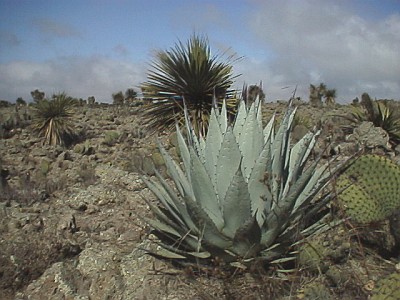
So today we took the bus to the central bus station (Caxa) in Xalapa in order to take the bus to Perote, and from there a bus to El Limón. The trip to Perote was very nice. The road goes quite high above the sea level, and for quite some part the bus was traveling in a cloud. When we arrived in Perote, it turned out that it was colder then we expected, so we went to a shop to buy a sweater for me, and a jacket for Esme.

When we walked back to the bus stop, the bus was just leaving. I signaled, was noticed, and we got on the bus. After a short trip we arrived in El Limón Totalco, and we decided to walk to the North, behind the town.
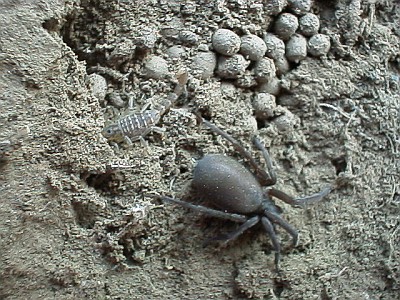
The landscape looked much more barren compared to the parts we had visited on earlier occasions. Also, it looked more dry, but that might have been the time of the year. It was quite cold, I guess around 12 degrees Celsius, and there was quite some wind. After some time, walking, looking under stones, and finding nothing, we came up on a dirt road, and I decided to look under stones near the road.
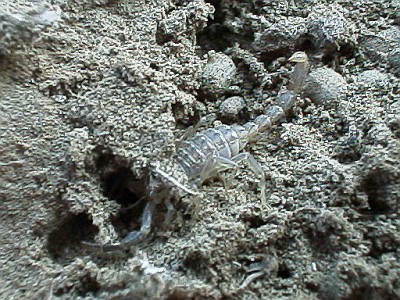
My experience so far has shown me that I often find more animals near the road, maybe because the boundary between road and the surroundings can be seen as an ecotone. And indeed, under one of the stones near the road I found our first scorpion of that day. I might have missed other scorpions earlier on, since as one can see in the above pictures, the color of this little animal matches very close the soil it lives on.

We walked a bit more. I was hoping to spot snakes, especially the conopsis species (probably conopsis lineata) we had seen on previous visits. But we didn't see any, although I found some shedded snake skin, probably belonging to this species.
Later, I found a nice burrow of a spider. In the above picture you can clearly see that the spider had to work around some of the protruding parts of the rock it is hiding under. A lot of rocks I have seen so far have very complex surface, many holes, wrinkles, etc. Excellent hiding places for, for example, small scorpions.
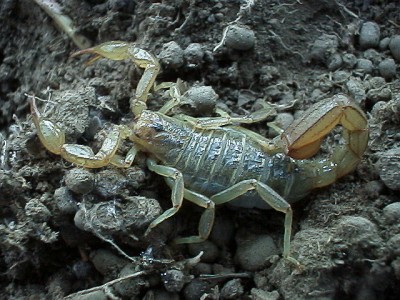
After quite some walk, I moved a stone, and saw something moving close to the edge of the uncovered hole: a small tarantula. Esme said: don't you see it? I was thinking the meant the tarantula, which was indeed hard to see. But she was referring to a very nice yellow colored scorpion. So I took pictures of the scorpion first and even carefully moved the scorpion on my hand to take a better picture.
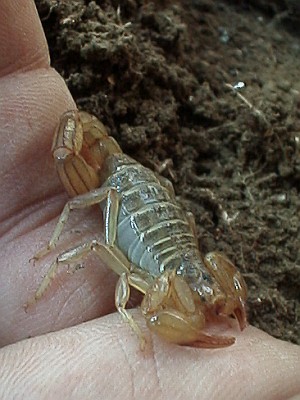
The small tarantula was of the kind we had seen before in similar places: quite dark with a small brown spot on its abdomen.
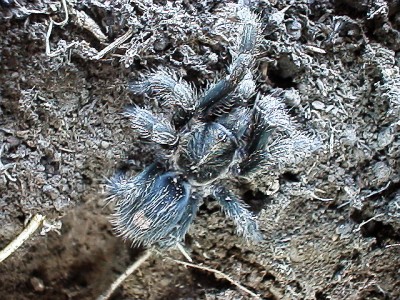
The stone we found both animals under was in quite a flat area with grass, between the volcanic rocks. I took a picture of the ground underneath the stone. It's quite amazing that two animals some people often wonder about what would happen if they meet, actually live under the same stone.

The scorpion, when I had put it from my hand back on the ground, had walked a bit closer to the edge, and when I had a closer look I noticed another. much smaller, scorpion trying to hide between the roots of the plants.
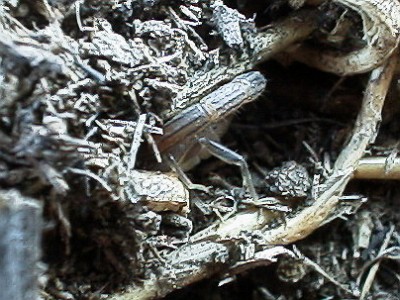
At one moment when I was taking pictures the small scorpion got very close to the much larger one. In the picture below you can see the chela (claw) of the large scorpion and the tail and a part of the body of the much smaller one.
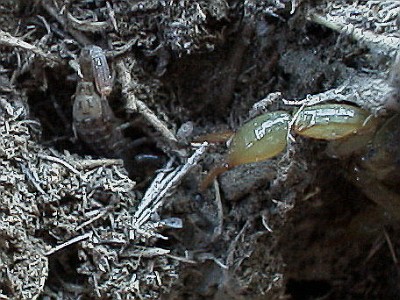
I moved the larger two animals away, so I could put carefully the stone back without having to worry about crushing them. The tiny scorpion had found a safe place between several roots, so I didn't have to worry about that one. When the stone was back in place, the scorpion, after a soft push, crawled back under it.
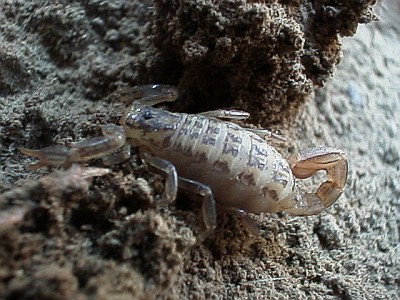
We continued our walk, and after some time, when I tried to move quite a big stone, two other stones moved as well, and Esme spotted a small scorpion. I turned the stone it was on around, and made enough shadow with my hand to make it stay in one place long enough for a few pictures. The small animal looked very fat, probably had eaten quite a meal recently.
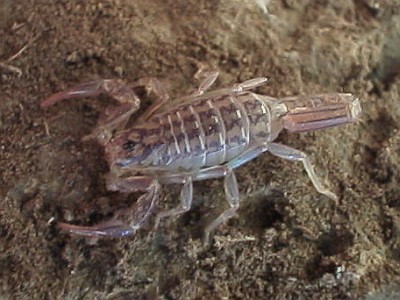
Somehow it got easier to find scorpions, maybe because we had decided earlier on to move more to the east, which looked greener. I found another small scorpion. I took a picture, and we moved on. Suddenly we came up a large spot, very flat. I joked that we found the soccer field of the scorpions. Because of the sun being very low I had to take a picture in the north-east direction, only showing a small part, since I didn't want to walk to far for just one picture.
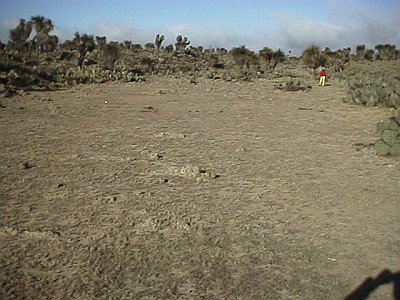
When I took the picture I recalled that I had seen much larger ones with Google Earth, and back then wondered what they were. At time of writing I probably managed to find back the flat part we saw using Google Local:
The flat spot is in the center of the image, roughly one kilometer below the much larger spot which is clearly visible, and almost to the right of another large spot.
I wonder what caused those flat parts, mostly covered by grass, it almost looks like people cleaned away most of the volcanic rocks, but I doubt that this is the case. Could it be that something stopped the lava flow?
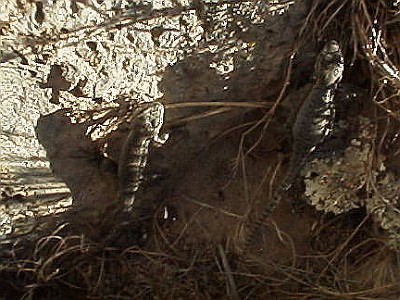
We decided to walk back, also because it was getting late, and the light was getting less and less. When we moved into a part that was a bit lower then the surroundings I saw a lizard when I moved a large rock. The lizard ran, and hid under another rock, and when I moved that another one was next to it. I tried not to scare the animals, and take a picture. Not a very clear one, but taking pictures of lizards is quite a difficult job.
After some time we arrived back in El Limón Totalco, and when we wanted to cross the road to the bus stop, the bus just arrived. We managed to signal the driver and got on the bus. We originally wanted to have dinner in Perote, but when we bought the ticket, the bus for Xalapa had already arrived, so we decided to take it and eat tacos al pastor at the bus station in Xalapa.
Although the place we visited looks quite dry, we saw now and then moss growing on parts of stones that didn't receive direct sunlight. The moss looked very green and healty, and when I touched it, it was clearly wet.
Also, the ground under the stones scorpions and/or tarantulas were hiding underneath was never dry. The ground when dry looks gray, and consists of very fine powder. Under the aforementioned stones the ground was closer to brown, felt moist to the touch, and was often mixed with organic material like roots, etc. Also, those stones when moved left a hole of about 5-10 cm deep, and the roots of nearby plants often had some hold on the underside of the stones, causing a soft ripping sound when I moved them.
I didn't see scorpions under stones that just rested on top of the soil. The ground underneath such stones was almost always very dry.